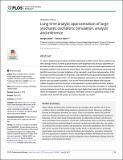Files in this item
Long-time analytic approximation of large stochastic oscillators : simulation, analysis and inference
Item metadata
| dc.contributor.author | Minas, Giorgos | |
| dc.contributor.author | Rand, David A. | |
| dc.date.accessioned | 2018-08-03T09:30:11Z | |
| dc.date.available | 2018-08-03T09:30:11Z | |
| dc.date.issued | 2017-07-24 | |
| dc.identifier | 255167562 | |
| dc.identifier | 0e5969ad-d1e5-4d96-87b9-b8d9b6c22254 | |
| dc.identifier | 85026660727 | |
| dc.identifier | 28742083 | |
| dc.identifier.citation | Minas , G & Rand , D A 2017 , ' Long-time analytic approximation of large stochastic oscillators : simulation, analysis and inference ' , PLoS Computational Biology , vol. 13 , no. 7 , e1005676 , pp. 1-23 . https://doi.org/10.1371/journal.pcbi.1005676 | en |
| dc.identifier.issn | 1553-734X | |
| dc.identifier.other | ORCID: /0000-0001-7953-706X/work/47136660 | |
| dc.identifier.uri | https://hdl.handle.net/10023/15761 | |
| dc.description | This research was funded by the BBSRC Grant BB/K003097/1 (Systems Biology Analysis of Biological Timers and Inflammation). DAR was also supported by funding from the European Union Seventh Framework Programme (FP7/2007-2013) under grant agreement n° 305564. BBSRC web site: www.bbsrc.ac.uk Seventh Framework Programme (FP7) website: cordis.europa.eu/fp7/home_en.html. | en |
| dc.description.abstract | In order to analyse large complex stochastic dynamical models such as those studied in systems biology there is currently a great need for both analytical tools and also algorithms for accurate and fast simulation and estimation. We present a new stochastic approximation of biological oscillators that addresses these needs. Our method, called phase-corrected LNA (pcLNA) overcomes the main limitations of the standard Linear Noise Approximation (LNA) to remain uniformly accurate for long times, still maintaining the speed and analytically tractability of the LNA. As part of this, we develop analytical expressions for key probability distributions and associated quantities, such as the Fisher Information Matrix and Kullback-Leibler divergence and we introduce a new approach to system-global sensitivity analysis. We also present algorithms for statistical inference and for long-term simulation of oscillating systems that are shown to be as accurate but much faster than leaping algorithms and algorithms for integration of diffusion equations. Stochastic versions of published models of the circadian clock and NF-κB system are used to illustrate our results. | |
| dc.format.extent | 23 | |
| dc.format.extent | 2680517 | |
| dc.language.iso | eng | |
| dc.relation.ispartof | PLoS Computational Biology | en |
| dc.subject | QA Mathematics | en |
| dc.subject | QH301 Biology | en |
| dc.subject | Ecology, Evolution, Behavior and Systematics | en |
| dc.subject | Genetics | en |
| dc.subject | Molecular Biology | en |
| dc.subject | Computational Theory and Mathematics | en |
| dc.subject | Ecology | en |
| dc.subject | Modelling and Simulation | en |
| dc.subject | Cellular and Molecular Neuroscience | en |
| dc.subject | 3rd-DAS | en |
| dc.subject | BDC | en |
| dc.subject | R2C | en |
| dc.subject.lcc | QA | en |
| dc.subject.lcc | QH301 | en |
| dc.title | Long-time analytic approximation of large stochastic oscillators : simulation, analysis and inference | en |
| dc.type | Journal article | en |
| dc.contributor.institution | University of St Andrews. Statistics | en |
| dc.identifier.doi | 10.1371/journal.pcbi.1005676 | |
| dc.description.status | Peer reviewed | en |
This item appears in the following Collection(s)
Items in the St Andrews Research Repository are protected by copyright, with all rights reserved, unless otherwise indicated.

